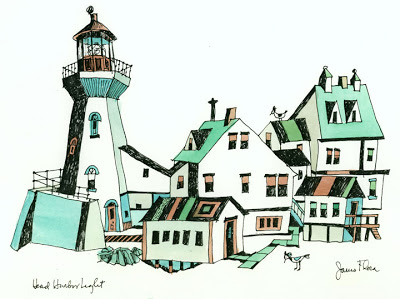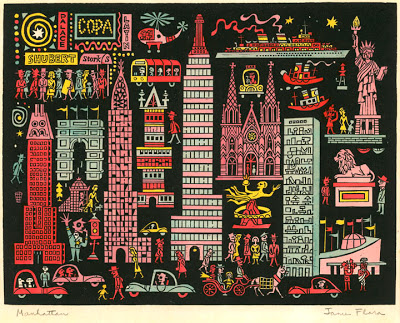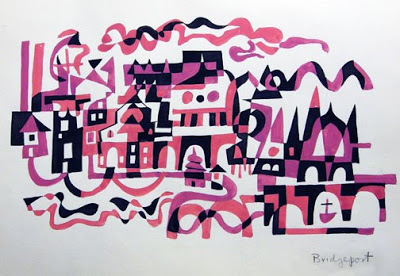Filed Under: "maritime"

Pen & ink with tempera, year unknown (ca. early 1990s). One of countless water’s edge works in the collection. Flora lived on Long Island Sound, loved boats, loved the seaside, and drew inspiration from all. Head Harbor Lighthouse, built from heavy timber in 1829, sits on Campobello Island in New Brunswick. It was the summer home of FDR.
Continue Reading... Head Harbor Light ►
Undetermined media (framed, under glass): print with touch-up, or black tempera, ca. 1968, detail. Another detail posted on December 2.
Continue Reading... Hampton Roads (pt 1) ►
We’ve finally collected an online gallery of Flora’s 20 children’s books (17 of which he authored). They’re up for viewing at JimFloraArt.com, the Flora family website. While you’re there, the site has had a makeover and includes three pages of original Flora art from the 1990s that’s being offered for sale.
Continue Reading... Kid-lit ►
detail, untitled tempera on paper found in sketchbook, ca. mid-1960s
Continue Reading... canoe critter ►
Illustration, Coda, March 1944, for Columbia Records release By the Sleepy Lagoon, by Eric Coates conducting the London Philharmonic Orchestra—available on a 12″ platter for the princely price of one buck.
Continue Reading... By the Sleepy Lagoon ►
Detail, The Big Bank Robbery, undated acrylic on board, ca. early 1960s complete work reproduced in The Curiously Sinister Art of Jim Flora P.S. Another detail:
Continue Reading... The Big Bank Robbery ►
Jim Flora Art LLC has produced a limited-edition, archival-quality fine art print of a 1954 Jim Flora hand-tinted woodcut entitled Manhattan. The cityscape depicts New York in its 1950s glory, including a number of gotham landmarks such as the Empire State Building, St. Patrick’s Cathedral, Madison Square Garden, the Statue of Liberty, famous theaters and legendary musical bistros, Washington Square arch, subways, taxis, horse-drawn carriages and tourists. Only twenty-five (25) prints of Manhattan were produced…
Continue Reading... Manhattan limited edition print ►
D.B. Dowd (Professor of Visual Communication, Washington University, St.Louis) opines: The modernist drive to split representation from its subject (that is, to open up a space between them, at the very least) included the ransacking of pre-modern art historical conventions, often to excellent effect. Jim Flora’s 1945 Coda cover draws on spot color printing and the use of spatial registers, a la Egyptian art, to deliver a strong graphic narrative with clarity and visual independence…
Continue Reading... Advanced Pictionary ►





